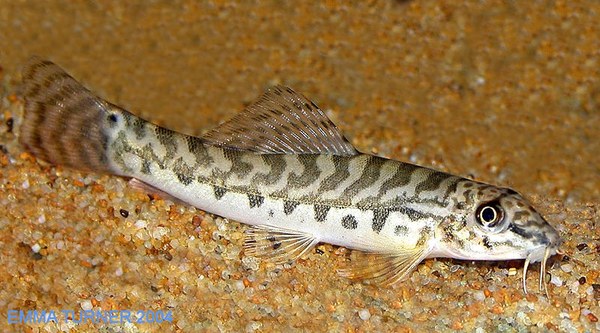Zipper Loach (Acanthocobitis botia)
Summary
Scientific name: Acanthocobitis botia (Hamilton, 1822)
Common name: Zipper Loach
Synonyms: Cobitis botia, Nemacheilus botia, Botia nebulosa, Botia mackenziei.
Distribution: Widespread - India, Pakistan, Nepal, Sri Lanka, Bangladesh, Butan,Thailand, Burma and Myanmar.
Sexual Dimorphism: Females fatter than males.
Maximum size: 3 inches.
Similar to: Acanthocobitis pavonacea, Acanthocobitis rubidipinnis, Acanthocobitis urophthalmus.

Care: Live in fast-flowing, clear streams and rivers. Appreciate rockwork or driftwood for secure cover, plus good aeration and reasonably good water movement.
Feeding: Accepts all regular aquarium foods, particularly loves Bloodworm and Daphnia.
Water parameters: pH: 6.5 -7.2 Hardness: Medium Max dh:
Temp: 75.2ºF to 78.8ºF (24 - 26ºC)
Breeding: Breeds in the wild around May to June. Has bred in aquaria, though it appears to be rare and accidental when it happens.
Notes
 This fish is a common import and relatively easy to keep. They habitually sift sand through the gills, extracting microscopic foodstuffs from within it. Therefore, they should be provided with a soft substrate.
This fish is a common import and relatively easy to keep. They habitually sift sand through the gills, extracting microscopic foodstuffs from within it. Therefore, they should be provided with a soft substrate.
Breeding Notes
On January 1st 2007, Rick Mau posted that he was changing the gravel in an aquarium housing two A. botia along with other species. The original substrate had been very large in size and they decided to put smaller grain size in.
 | As can clearly be seen, gravel in the tank is now substantially smaller than the previous substrate. AA cell batteries provide scale. |
While pulling out all the plants and decor, two baby fish were found.
 | Here they are on the new gravel. It is obvious that they are young Zipper loaches. It seems that the large substrate allowed the eggs to fall through and not get eaten. These two fry obviously missed predation by other tank mates until big enough not to be viewed as food. |
 | This is Mom. |
 | Here's an attempt to gauge the size. |
 | The two little guys are out and about a lot it seems. |
 | This Tetra gives some indication of size. |
 | A closeup shows how well the eye spot on the caudal upper base, plus the caudal markings are designed to confuse a predator. |
 | A better size gauge. Rick says the log is 3.5 inches in diameter. |
 | Here is the tank settled down after the substrate change. The parents are visible close to one another. |
As stated above, most successful breeding of this species is by chance, but congratulations to Rick anyway on the new offspring and thanks for sharing the experience.
Photo Gallery
Click to view all images of this species! |
Document Actions

